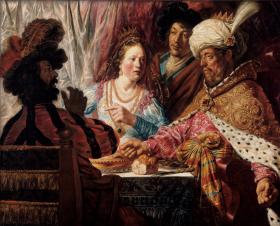
One of the most dramatic moments from the Book of Esther comes when the queen accuses the king’s advisor Haman of treachery against her people (Esther 7:1–7). Through her efforts, Haman’s plot for the slaughter of all the Jews in Persia was unmasked before King Ahasuerus (Xerxes). Seated before his chamberlain, Harbonah, the king reacts in anger with arms outstretched and hands clenched. Across from him sits the isolated, shadowy figure of Haman, who cowers at the king’s wrath. Shortly thereafter, Haman’s life would end on the gallows.
The broad, painterly style, bold colors, and dramatic energy of The Feast of Esther has much in common with works produced by the young Rembrandt in his native city of Leiden. In fact, the picture was formerly attributed to Rembrandt. Nevertheless, the artist of this provocative work is now identified as Jan Lievens, Rembrandt’s slightly younger and more precocious Leiden colleague. The picture shares many similarities with other examples from Lievens’s oeuvre. In its scale, clarity of spatial organization, bold palette, and description of materials, the painting is the masterpiece of the artist’s youth.
Painted during a period when Lievens and Rembrandt may have shared a studio, the painting calls attention to the differences between their works. The scholar and art lover Constantijn Huygens, the first to discuss both artists, wrote in the early 1630s that Lievens’s paintings from the 1620s had a grandeur of invention and boldness that Rembrandt did not achieve. The Feast of Esther confirms his insightful opinion.

